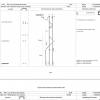Lowestoft used to/may still be, 60mph straight out of some of the platforms I believe.
NESA implies this still is the case.
There is a '55' marked, on the Up, between Lowestoft SB and Oulton Broad North Jn, between 23m 16c and 22m 58c.
Lowestoft used to/may still be, 60mph straight out of some of the platforms I believe.
NESA implies this still is the case.
There is a '55' marked, on the Up, between Lowestoft SB and Oulton Broad North Jn, between 23m 16c and 22m 58c.
Here is the relevant NESA page (1-April-2019).The 55 is new I think, if I'm remembering correctly the Lowestoft line was 60 throughout (with a few 10 mph points in the station itself) except for the two swing bridges and the approach to Reedham.

Its the nature of the beast to arrive slightly early as the vast majority of terminii will have engineering/box time on the approach. You shouldn't be planning trains without an eye on the platforming anyway and if it does cause an ongoing problem then the turnaround times should be challenged.On numerous occasions I've stopped in the station throats of Paddington; Kings Cross; and Euston - mostly due to running a minute or two early, and thus having to either wait for the platform to become available or to allow a departing service to clear the route forward into the platform.
If trains arrived quicker (in succession / time) at certain stations, they wouldn't be able to be accommodated due to having full platforms. By slowing things down on the approaches there is more time to turn the previous arrivals around and get them departed before the next wave of arrivals.
Additionally, if there is a red aspect (signal) at the last gantry before the terminus - for conflicting departures for example - they will have to start slowing on the approach to the Double Yellow (about 1.5 miles out in the case of paddington). If there is a lot of point work to negotiate in the throat, this could be another reason to be going slowly - passengers standing in the vestibules are more easily thrown about than those in seats.
View attachment 67924 View attachment 67924
Here is the relevant NESA page (1-April-2019).
(apologies if it is a tad small in the writing)
View attachment 67924
Yes, to the 10 mph points, at the station end.
I don't know what the 55 mph restriction might be for.
With places like Paddington, a lot of the time additional padding is required to make the conflict margin of a departing service across the path of the incoming service.Its the nature of the beast to arrive slightly early as the vast majority of terminii will have engineering/box time on the approach. You shouldn't be planning trains without an eye on the platforming anyway and if it does cause an ongoing problem then the turnaround times should be challenged.
It may also be down to how tight station throats are. Keeping the speed low means you can have sharper curves and pointwork.
Increase the line speed, and the points and curves have to be shallower, thus making them longer, moving the throat further from the station. This will then eat into capacity.
Lower speeds also mean you get shorter signal sections, which can help improve capacity.
Paddington throat is much longer and wider than that at Liverpool Street, which is constrained in a deep retained cutting and a parallel tunnel on a very tight curve. There was much less scope for speed increases at Liverpool Street for approach and departure when the layout was renewed. With the revised speeds at Paddington after the Ladbroke Grove review, it's possible that some of the turnouts, especially those very close to the ramp ends, might have been specified marginally slower and cheaper than in the initial 1990s remodelling, but overall the new layout is still highly fit for purpose.Compare Liverpool St with Paddington as an example of what you are saying. Platform reoccupation at Liverpool St is far sharper than at Paddington.
It would be interesting to know how the design for the current layout at Paddington was arrived at, and whether if the designers had their time again they would do anything different, even without the Ladbroke Grove crash.
I don't think I am able to comment on what goes on at Liverpool Street.Compare Liverpool St with Paddington as an example of what you are saying. Platform reoccupation at Liverpool St is far sharper than at Paddington.
Orginally, the steamers arrived into the topside (high numbers) and we're dragged out to Old Oak to be serviced, etc. The empty stock then came back over the ECL into the bottom side (low number) for boarding.It would be interesting to know how the design for the current layout at Paddington was arrived at, and whether if the designers had their time again they would do anything different, even without the Ladbroke Grove crash.
